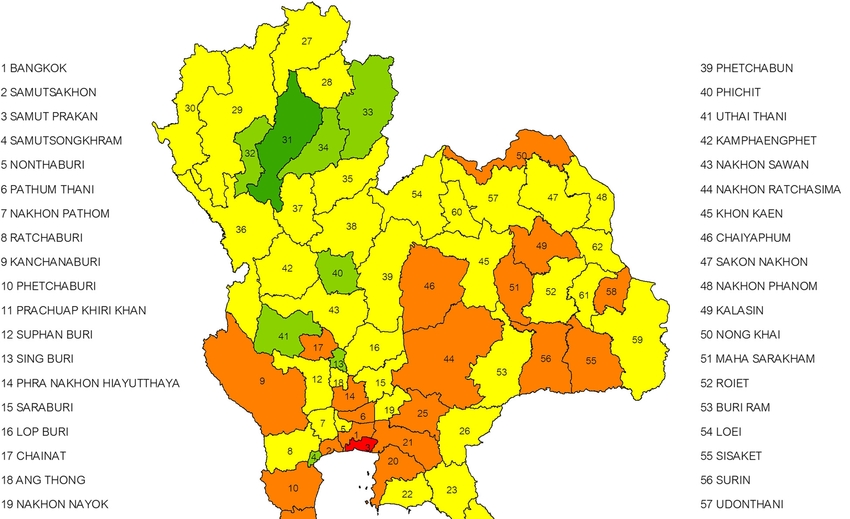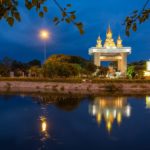
Sakon Nakhon Province: A Thailand Spiritual Mecca

From November 12th (1949) to January 1st (1950), Buddhist monks, Thai political leaders, and people from all walks of life throughout Thailand traveled to pay their respects to Ajarn Man Phurithatto (มั่นภูริทตฺโต), whose body lay in state at Wat Pa Sutthawat in Sakon Nakhon, where the revered and aged Thai monk had spent his final months.
Prior to moving to Wat Pa Sutthawat (วัดป่าสุทธาวาส), Ajarn Man had spent the previous 5 years at Wat Pa Ban Nong Phue (วัดป่าบ้านหนองผือ) in Sakon Nakhon, a forest temple which now goes by the name Wat Pa Phurithatta Thirawat (วัดป่าภูริทัตตถิราวาส). Ajarn Man knew that tens of thousands of people would be coming from all directions to pay their respects to him upon his death. He worried about the disruption to wildlife and forests that this would cause. So, when he knew that his final days were approaching, he traveled to Wat Pa Sutthawat in Sakon Nakhon City, which had better infrastructure to handle the enormous influx of people.

Sakon Nakhon Province & Thai Buddhism
Ajarn Man’s final years in Sakon Nakhon earned the province the reputation as one of Thailand’s most important spiritual Meccas. During the late 1800s and early 1900s Ajarn Man (also spelled Ajahn Mun), along with his mentor Ajarn Sao Kantasīlo (อาจารย์เสาร์ กนฺตสีโล), wandered the forests of Thailand and neighboring countries, establishing what would become the Forest Tradition of Therevada Buddhism.
Their wanderings included the dense forests of Sakon Nakhon. The province’s beautiful meandering mountains have many caves and paths that are perfectly suited for Buddhist monks who wish to practice forest meditation and commune with nature. To this day Sakon Nakhon attracts Thai monks from across the Kingdom to its many forest and mountain temples.
That Ajarn Man chose to spend his final years in Sakon Nakhon province demonstrates the spiritual importance the ascetic monk attached to the province. Just as Bodh Gaya (the village where the Buddha achieved enlightenment) is located in the northeast Indian state of Bihar, Sakon Nakhon is located in the Northeast region of Thailand known as Isaan. Footprints of the Buddha are said to have appeared in Sakon Nakhon, most famously at the city temple Wat Phra That Choeng Chum.

The Spiritual Energy of Sakon Nakhon Province
The unusual “spiritual energy” of Sakon Nakhon province (both good and bad) has long been the talk of legend. Sakon Nakhon was once home to Thailand’s haunted village, a rural village populated by alleged ghouls known in Thai as “phi pob” (ผีปอบ). These ghouls had been cast out of their home villages and alleged to be possessed, until a Thai monk built a holy well whose water cured them of the evil spirits.
Then there are the many stories of Sakon Nakhon monks who have been led by spirit guides, such as Luang Pu Phu Phan of Wat Non Sawan, and monks who have demonstrated miraculous powers, such as the Thai bulletproof monk Phra Ajahn Wan Uttamo (พระอาจารย์วัน อุตตโม) of Wat Tham Apai Damrongtham, who earned the respect and patronage of King Bhumibol the Great.
Sakon Nakhon province also was home to the largest number of Seri Thai freedom fighters during World War II. Led by Sakon Nakhon native Tiang Sirikhan, their tenacity and fearlessness was a testament to the spiritual courage of the Sakon Nakhon people and the value they placed on personal freedom.

Sakon Nakhon Province on the Map
The name Sakon Nakhon itself (which translates to “City of Cities”) suggests its stature as a Thailand spiritual Mecca, as does the province’s shape on a map. Sakon Nakhon’s provincial boundaries are in the shape of a boot that evokes the foot of the Yaksha Giant Thao Wessuwan, a powerful and protective Buddhist deity who both guards against evil spirits and grants prosperity. The largest Thao Wessuwan statue in Thailand is not surprisingly in Sakon Nakhon.
Among the 76 provinces of Thailand, none has a similar booted shape. When looking at a map, Sakon Nakhon immediately attracts the eye as someplace special. And indeed it was recognized as such by the Hindu worshipping Khmer civilization that once ruled over the region. Remains of ancient Khmer temples can be seen in Sakon Nakhon, such as Phra That Phu Phek, which some researchers believe was the cosmic center of the Northern region of the Khmer empire.

Royal Residence in Sakon Nakhon
We might also view Sakon Nakhon province as a Thailand spiritual Mecca due to it being home to the only Royal Residence in the Northeast of Thailand. The King of Thailand, currently King Maha Vajiralongkorn, is the upholder of the Buddhist religion in Thailand, and the traditions of Thailand’s Royal Family are steeped in both Buddhist and Hindu traditions and iconography. That King Bhumibol Adulyadej chose to build his Isaan Royal Residence in Sakon Nakhon (1975) certainly is of symbolic importance.
To learn more about Sakon Nakhon province, visit our Sakon Nakhon History. To discover spiritual destinations, visit our article on Thailand Spiritual Retreats in Sakon Nakhon.
- The Royal Ploughing Ceremony in Thailand – A History - May 8, 2024
- Dying Well the Buddhist Way in Thailand - May 7, 2024
- Comforting Words for the Brokenhearted in Thailand - May 6, 2024




